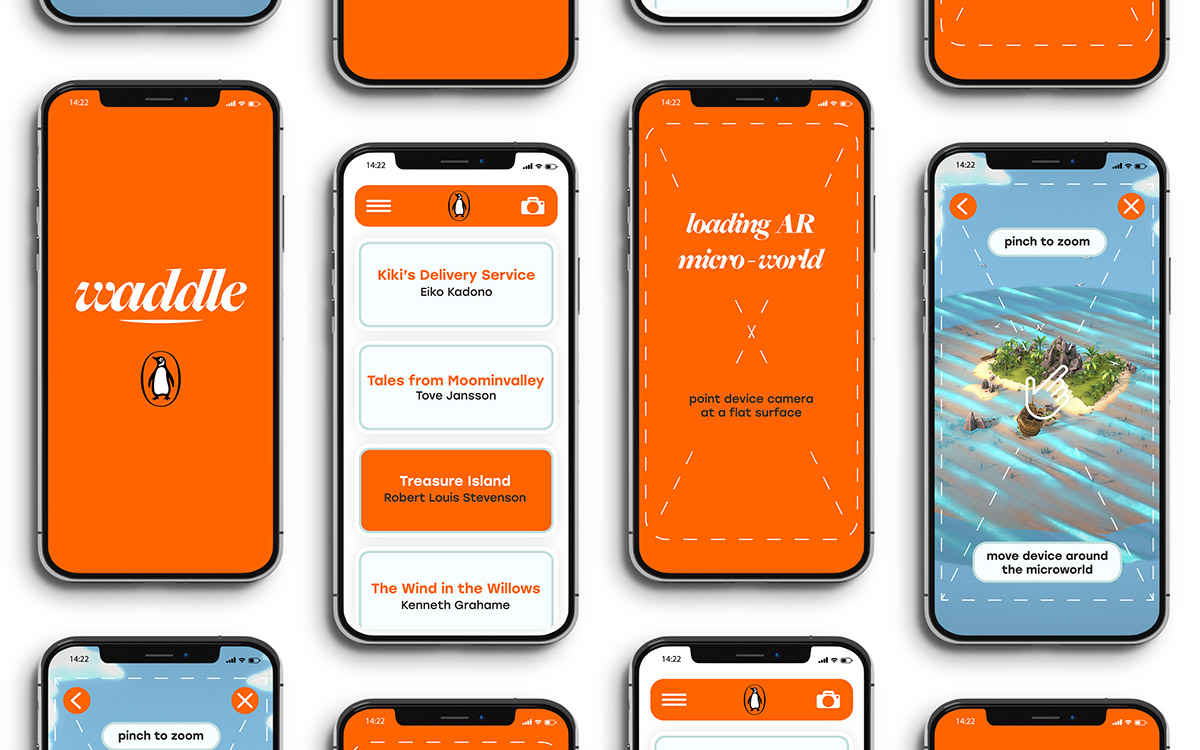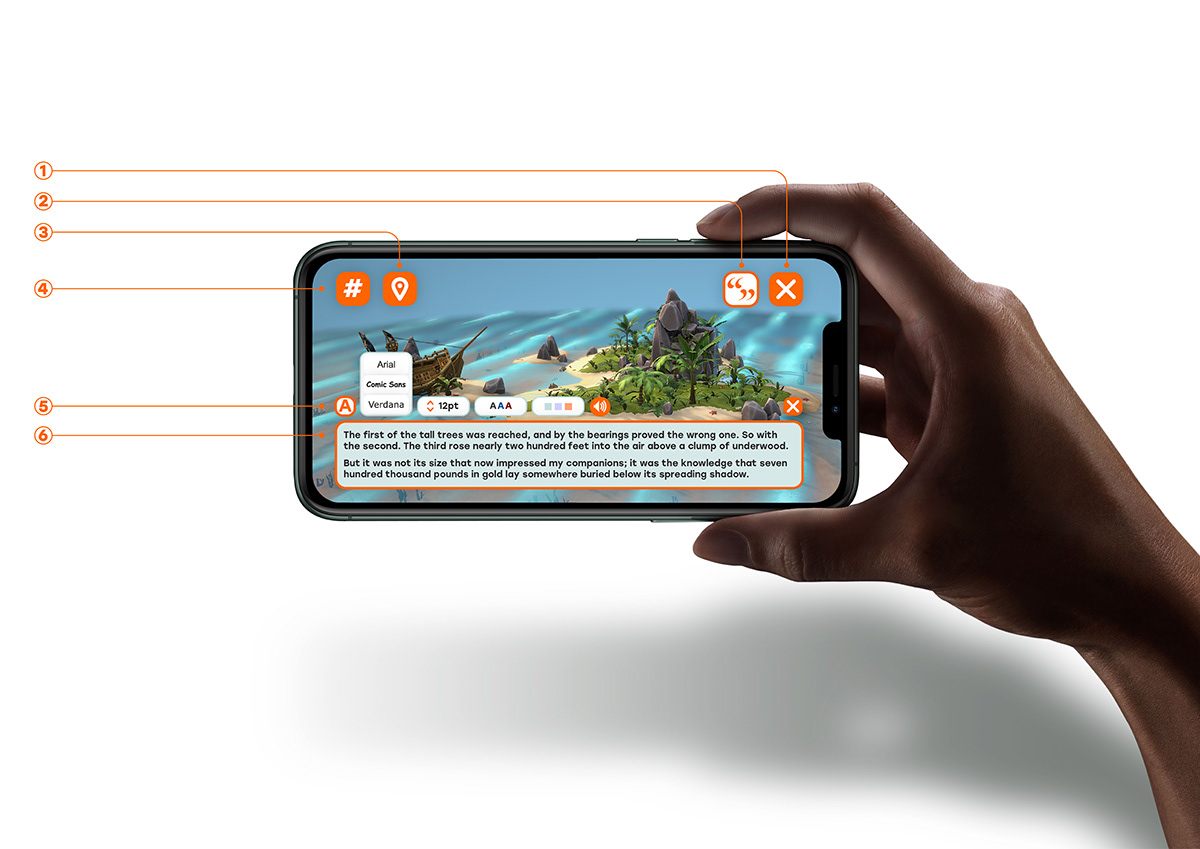D&AD: Penguin

Waddle
Waddle is an immersive reading experience for Penguin Books, visualising books in a new way that makes them more enjoyable and appealing for dyslexic children aged 6-12 years. Our pop-up experience allows readers to step into the world of a book using multi-sensory technology to create an engaging event. This will be an opportunity for families to visit together as well as school trips, creating conversation and new interest in books. Our immersive reading experience is targeted at those with dyslexia but will be beneficial to all. Visitors are encouraged to share their experience on social media via #Waddle. The Waddle app makes the immersive reading experience accessible at home through augmented reality. Our immersive reading experience will benefit children academically whilst bringing the joy back to reading and making it an unmissable part of pop culture.
“Only 35% of children say they enjoy reading” (Ferguson, 2020). We wanted to tackle school children’s lack of enjoyment or struggle with reading, particularly those with dyslexia. These students may be disadvantaged in literary subjects – and reading for pleasure, and fall behind their peers in these areas. Our immersive reading experience will make books enjoyable and accessible for dyslexic children who as ‘picture-thinkers’ learn better through multi-sensory experiences (Bentley, 2018). A physical pop-up experience and an augmented reality app will allow readers to explore their book’s world, promoting diversity and equality through an alternative to text-based thinking.

P R O B L E M
“1 in 5 children in England cannot read well by the age of 11”
“Only 35% of 10 year olds say they enjoy reading”
“Children with learning difficulties are at greater risk of developing mental health problems”
The Reading Agency. n.d. Reading facts. [online]
Ferguson, D., 2020. Children are reading less than ever before, research reveals. [online] the Guardian.
The main issue we wanted to tackle was school children not enjoying or struggling with reading due to a lack of approaches that are inclusive for all types of learners. Particularly dyslexic children find themselves disadvantaged in literary or language subjects, - and reading for pleasure, and fall behind their peers in these areas. Therefore, dyslexic school children will be our primary audience for whom we chose to create something exciting and fun, but also academically beneficial. However, as we wanted to abide by the Penguin ethos of availability to all and make something that would engage with everyone in a new way of reading and spark conversation – being worthy of sharing on social media, making books an unmissable part of pop culture. Using a physical space as well as a digital interactive space, we decided to create an experience you can share with others, so reading is no longer so a solitary activity.
S O L U T I O N
Our solution is an immersive reading experience utilising interactivity and augmented reality. It consists of two parts; a pop-up experience and an interactive app which are designed to create a new buzz around books. Visitors of the pop-up experience will enter a dome shaped space, resembling an igloo, surrounded by screens which immerse the reader in the setting or scene from a book of their choice. This spectacle will spark conversation and interest on social media and inspire people to pick up a new book. Pictures, videos, and selfies are welcomed and encouraged and can be shared using #Waddle. Our pop-up experience will be a fun family event, and open to school trips to encourage children to read more. Offering a visual alternative to text-based thinking will make reading more accessible and enjoyable for children who do not read often. Our immersive reading experience can be an educative tool as we found that dyslexic children learn better through multi-sensory experiences and methods.
Visitors will be invited to download the Waddle app on entrance to the pop-up experience. They can use the app within the space and remotely using AR to visualise a book’s world, allowing the user to venture around the story they are reading. A key scene from each chapter will be displayed, and interactive elements can be completed in line with the story. Quotes can be used in conjunction with the visual to make the content accessible for all types of learners while helping readers to maintain engagement with their books. All fonts, font sizes, text colours, background colours and layouts are designed with the learning needs of dyslexic children in mind. The game-like element of exploring and following a story will create interest, and people can share their progress and experience on social media. The app and pop-up experience will also be promoted through a social media campaign, encouraging shares, instagram stories of the pop-up experience as well as the activities and adventures being completed on the AR app.
British Dyslexia Association. n.d. Dyslexia friendly style guide.
R E S E A R C H
We began by researching the Penguin brand, its origin and history. We learnt that Penguin is all about inclusivity and equality for all. Books should be accessible to everyone, and are a tool for inspiration, creativity, and conversation. We analysed experiences which inspire the same reaction and impact that Penguin strive for. We looked back to our own personal experiences and found that immersive visual experiences create a lot of conversation and excitement. We thought the use of surround screens produces an immersive sensation of the sublime which is strongly engaging. An article from the Davis Dyslexia Association International analyses how VR and immersive experiences more generally can help dyslexic students with comprehension: “Dyslexics typically respond better to multi-sensory experiences. They are picture-thinkers who specialise in mental imagery rather than word-based thinking” (Bentley, 2018) Meaning tasks like reading a book with no imagery can be incredibly difficult. These visual and immersive elements show signs that these students can retain information and apply it more successfully when learning this way. Thus, making it the perfect activity for a school trip or for families.
Alongside this pop-up experience, we wanted readers to be able to visualise their books anywhere. Using a phone/tablet to do this will be accessible to the majority. We researched augmented reality and discovered a method for visualising a space and scene in great detail called a micro-world. We thought it would be a fun and engaging part of reading to be transported to the setting of the book you are currently reading, explore it as a micro-world and complete tasks in line with the story. A QR code could be displayed at the end of each chapter including key quotes from the text alongside the micro-world. Multi-sensory technology should be utilised in education, making reading inclusive for children with learning differences: “AR is an ICT tool that enables users to see and experience the real world mixed with various virtual objects. It can benefit dyslexic students and their educators since it can transform the learning procedure into more stimulating and entertaining (experiences)” (Karamanoli, Tsinakos, 2016). These interactive features will provide children with more joy and excitement in their education, while everyone will enjoy this new way of reading.
Bentley, J., 2018. How VR Can Help Dyslexic Students. [online] Dyslexia the Gift Blog.
Karamanoli, P. and Tsinakos, A., 2016. Augmented Reality and Dyslexia: A New Approach in Teaching Students.

W A D D L E A P P
The Waddle app will be downloadable on entrance to the pop-up space, as well as being advertised for use anywhere. The user can open the app, select a book from the range available, and load into the micro-world of their story. On the interface shown on the next page, the list of books displays a range of Penguin classics and modern classics suitable for 6-8-and 9-12-year-olds. In the example shown below, Penguin’s Puffin classic ‘Treasure Island’ by Robert Louis Stevenson is selected, the user is then transported into the world of the book and free to roam around using their device. In this story the reader could follow a virtual map as the character Jim does in the book, encountering the character Ben Gunn in a game-like scene and carry out the search for the treasure. At the end of each chapter the relevant scene will be displayed after scanning the QR code using the camera tool in the app in conjunction with key quotes from the text. Additionally, a summary of the chapter will be provided to refresh the reader’s mind. Readers can customise the appearance of all text, making the individual reading experience as accessible as possible with all fonts, font sizes, text colours, background colours and layouts designed with the learning needs of dyslexic children in mind.

A R M I C R O - W O R L D
1. Exit Micro-world. This icon allows the user to back out of the current micro-world and return to the home page, where they can switch books.
2. Information. This icon will open the bubble shown below, containing key quotes and summaries from their current chapter to help them explore or complete tasks in the micro-world and progress. The user can select their chapter and page number for easy use.
3. Map. This icon will open a map of the current micro-world, to help the user navigate. In this example, displayed on the previous page is the Treasure Island map, to locate points of interest, or the hidden treasure.
4. Hashtag. This icon will take the user to the trending #Waddle posts on Instagram, TikTok and more, inspiring them to share their own reading experience.
5. Text. This icon is an important feature for children with learning differences, as this allows for customising the font style, size, text and background colour. According to the British Dyslexia Association, sans-serif fonts of 12-14-point size are best. Text colour should be dark on a light, soft-pastel background - not white. Additionally the icon on the right of the bar affers a the text-to-speech function.
6. Quotes. This icon presents a key reading element in the app, including short quotes and a summary of the chapter to assist with reading comprehension.

C A M P A I G N
These posters are an example of the advertising campaign, which can also be posted on social media. The QR code on the poster takes you to a website to get a sneak peak of the AR experience.

Thanks for reading.








